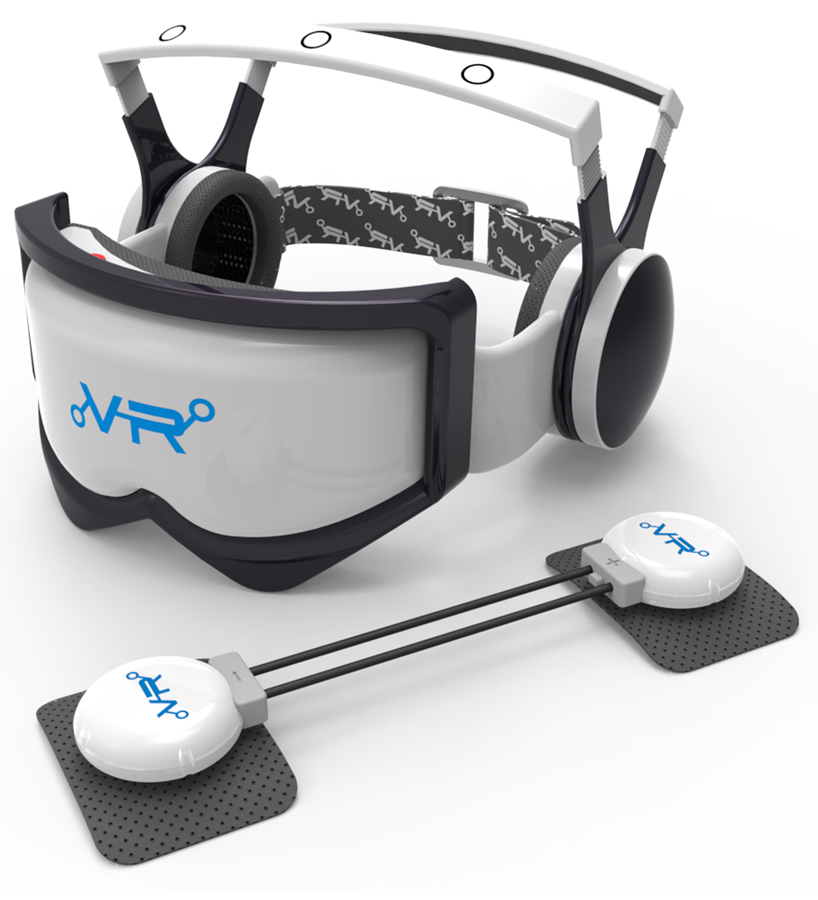
Virtual Rehabilitation by Lei Design from uk
designer's own words:
The main underlying concept:
Three different technologies will merge together to create a new training/rehabilitation equipment to give mental and muscle training using virtual reality and electronic muscle stimulators. The three main technologies are:
- Head mounted display (HMD) to portray a virtual reality world using two screens in front of the eyes. Internally will be circuit boards and tracking systems.
- Sensors which uses brain-computer interface based on electroencephalography technology (EEG). This will work in conjunction with the HMD to enable the user to control a virtual character in the virtual environment using his/her thoughts. An EEG acquisition module will be integrated with the sensors which analyse the neuron activity detected by the sensors.
- Wireless electronic muscle stimulators (EMS) which induces electric impulses to the user’s muscle region. This will work in conjunction with the EEG acquisition module to give different frequencies of electric impulses to the muscle region depending on the level of difficulty of movement being done in the virtual world.
Why am I doing this project?
In terms of the fitness/sport industry mental training in the form of positive thinking and images helps athletes to perform well when it comes to the actual moment, using virtual reality will give the athlete a more intense mental training while training their muscles at the same time.
In terms of the medical field application, global population continues to age, and therefore more and more adult/elderly people are on the risk of having stroke at some point in their lifetime. Research shows that visual aid increases the recovery rate of stroke patients into being able to control body parts which undergoes ‘learnt disuse’ (a term which states that the brain forgets how to function that part of the body).
What am I trying to accomplish?
Virtual reality is an emerging new technology which is starting to make its way into the market, but in the form of gaming and entertainment systems. This project will look at how virtual reality technology (a vast visual interface) can be implemented into providing much more effective rehabilitation for stroke patients and give athletes a better mental training to improve their performance.
Why is this project needed?
Following a stroke, in order for motor recovery to occur, it is essential that the brain undergo reorganisation. In simple terms, after having a stroke, parts of the brain are damaged and that why certain body parts cannot be controlled by the patient. Research shows that virtual reality therapy stimulates neuroplasticity (the ability of the brain to reorganize itself) this is because neuroplasticity in the brain is triggered by regular stimulation of that area via an activity that involves the function the area supports. Essentially, the task given in the virtual reality world will encourage more neuroplastic changes since the patient’s motor imagery skill is being trained.
For athletes, coaches invest huge sum of money to improve their athlete’s performance. Research shows that psychological tools allow an athlete to maximise performance by entering a competition with the ‘proper mindset’. Training both physical and mental performances make up a successful athletic performance.
Why am I doing it now?
Due to technological advancement, semi immersive virtual reality is being developed. In the current market, this type of technology is being used in gaming, in the form of a device called Oculus Rift. This device uses a head mounted display to display the virtual world, however to control your virtual self, you need controllers such as keyboard, joystick, etc. This project will look at using a non-invasive Brain-Computer Interface to be able to control your virtual reality character. Non-invasive BCI will require EEG (Electroencephalography) technology to work. Basically it will require several electrodes to be placed in the scalp to record brain activity.
Who are we designing it for?
One of the main target markets of this project will be elderly people since more than two-thirds of stroke patients are over the age of 65. This is why BCI is essential since it just requires the patient to just sit in the bed and get rehabilitation via virtual reality. Basically BCI will enable the patient to control his/her virtual reality self, the view that the patient can see in the virtual world is in first person. This interface will encourage the development of neuroplasticity in the brain as more tasks are done by the patient in the virtual world. Alongside this visual therapy, the patient also gets rehabilitation in the real world, which focuses on improving motor functions in affected limbs which is in the form of a wireless electronic muscle stimulator (EMS). The wireless EMS works alongside the virtual reality software; basically it will be placed on limbs which needs to regain motor control. The way this will work is that, the EMS will induce electrical current to the muscle area, making it contract and relax (mimicking the action of being used in movement); the frequency of the electrical current given will be determined by the difficulty of the movement being portrayed in the virtual environment. Therefore, if the patient is thinking of running, and this is being portrayed in the virtual environment, the leg muscle will receive a higher stimulation compared to if the action being done is walking. Task given to the patient will be sent by a therapist via Telerehabilitation, these tasks can simulate occupational therapy, which is relearning skills needed for everyday living. The therapist can tap into the patient’s device and obtain information on whether the patient is recovering or not. If the therapist feel like the patient is improving, these tasks can have their difficulty raised, to further improve the recovery of the patient.
The other main target market that can use this concept will be athletes, typically teenagers and young adult. This is because for different sports there are different peak ages (the time when the athlete’s performance start to degrade). This can apply to all ages who want to get better mental training to improve performance. The BCI technology as stated above is the main feature that trains your mental performance this is because it requires you to think before actions are done in the virtual environment. Alongside the virtual training, wireless EMS for this particular user group is used for muscle strengthening/conditioning for a better physical performance.
What is the current and anticipated business environment for the results of this design project?
The current business environment of this design project will be the medical field and the sports industry. In terms of the medical field, the Government invest vast amounts of funding to get concepts like this to be created and test, to see whether it will actually increase the recovery rate of stroke patients. In the sports industry, coaches spend a huge sum of money to buy better equipment to improve an athlete’s performance. The Olympics is one of the underlying reason that encourages the improvement of athlete’s performances, every countries desire to represent themselves with high performing athletes to earn medals. Countries spends vast amount of money on hosting the Olympics, it is estimated that £24bn was used to host the London Olympics.
A complete render of the VR headgear and the VR Stimulator.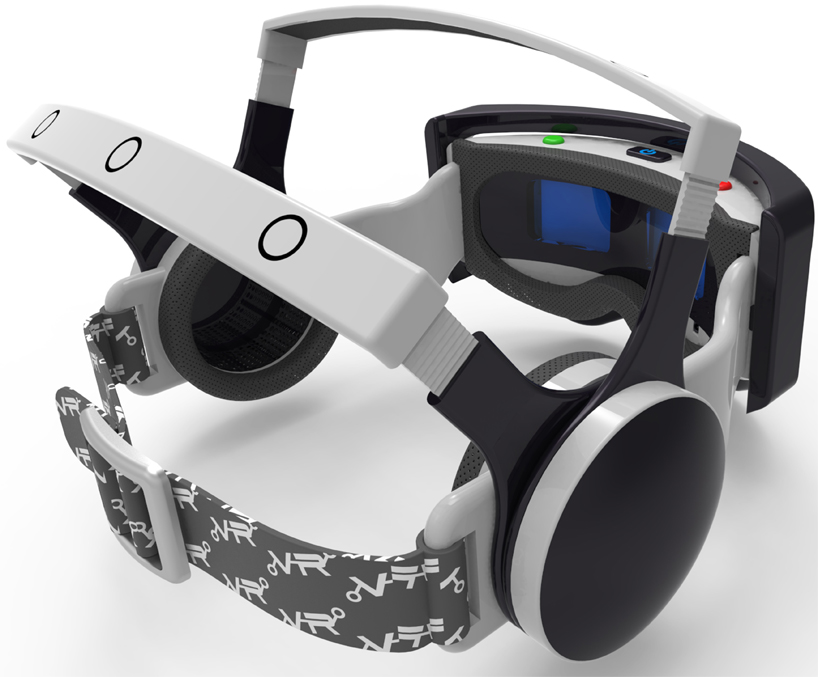
A rendering of the VR headgear in another view to show more details in how it works. It is similar to other Head Mounted Display in the market, however it consist of an EEG sensor and a built in headphones.
http://youtu.be/vg1rM4_SbTc?list=UUQ8wOfKH84Wm9u57pKwJiwA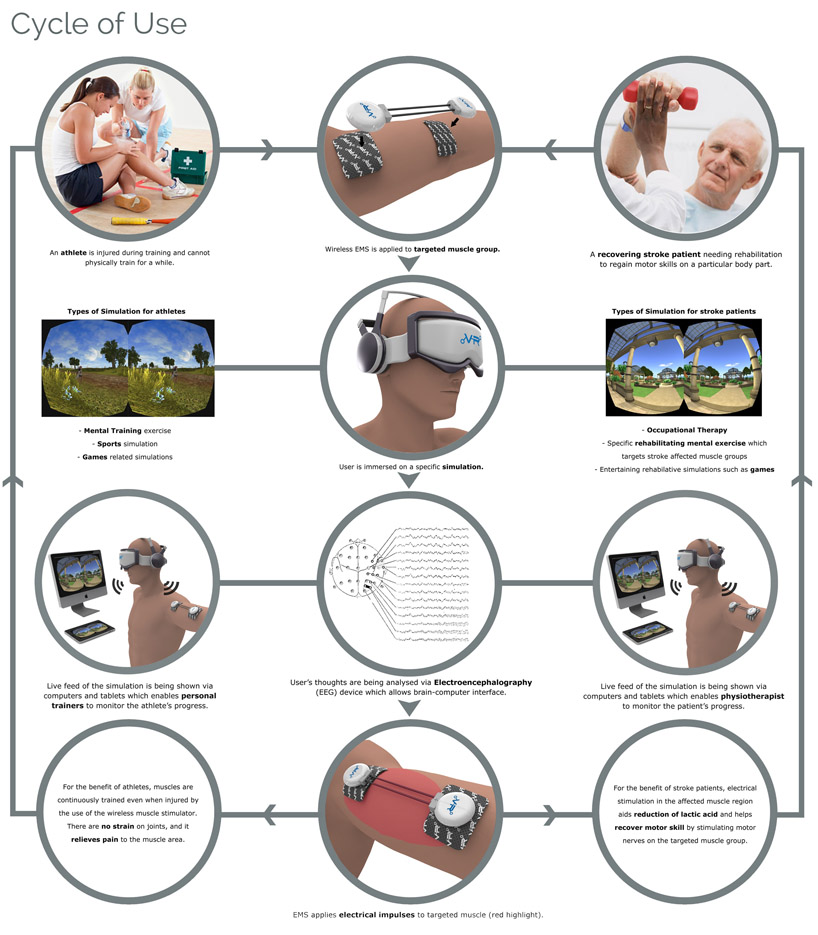
This is the cycle of use for the design. It shows an example of how both target market (stroke patients and athletes) can use the product. 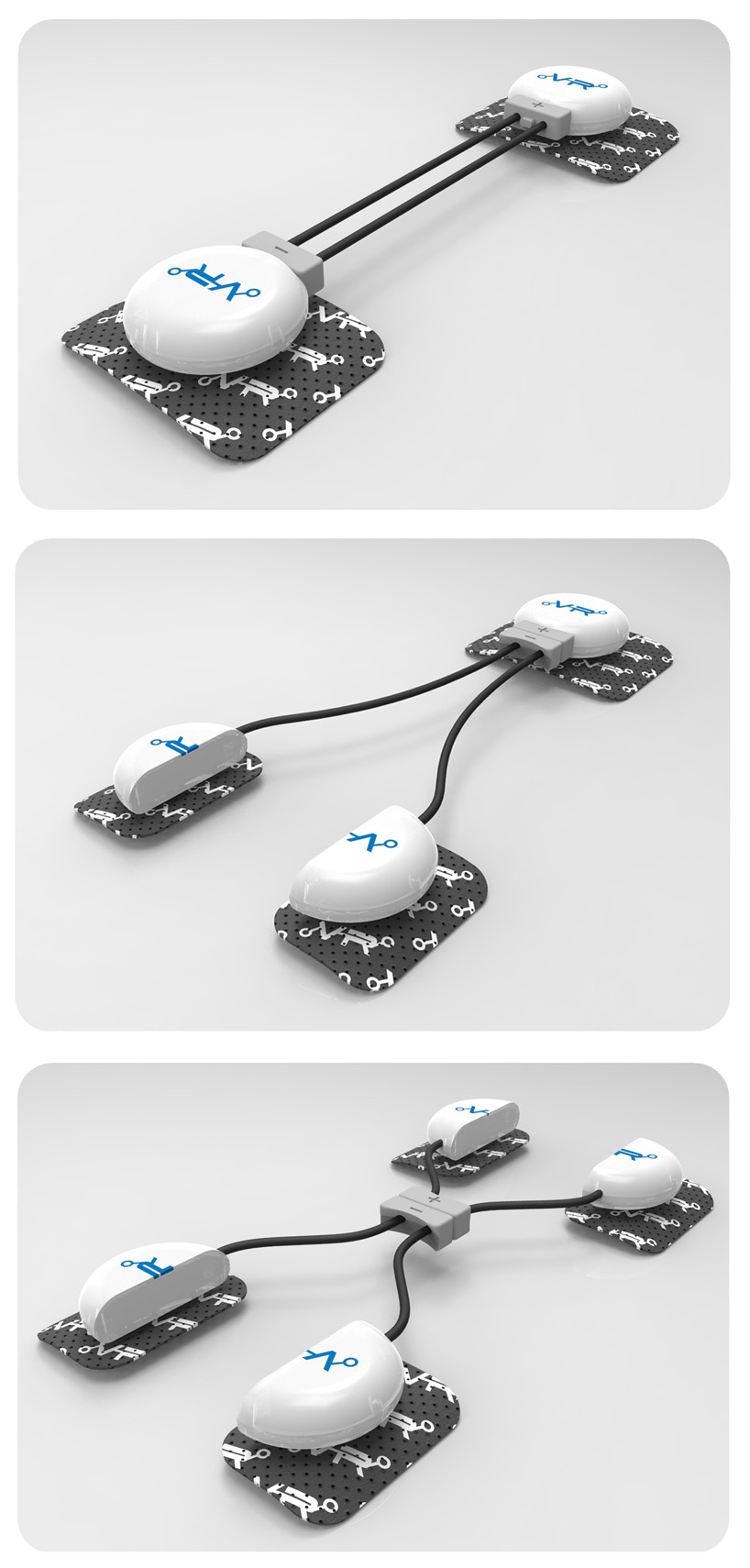
It is a multifunctional muscle stimulator which can be used in three different ways to train the muscles. There are three different modes of use, the 1-1, 1-2 and the 2-2. With the use of the slider, the user can change into different modes easily. The exclusive feature it contains is the ability to split the main Electrical Muscle Stimulator (EMS) shape into two smaller EMS in order to induce electrical charge into a larger surface of muscle to train larger muscle groups more effectively.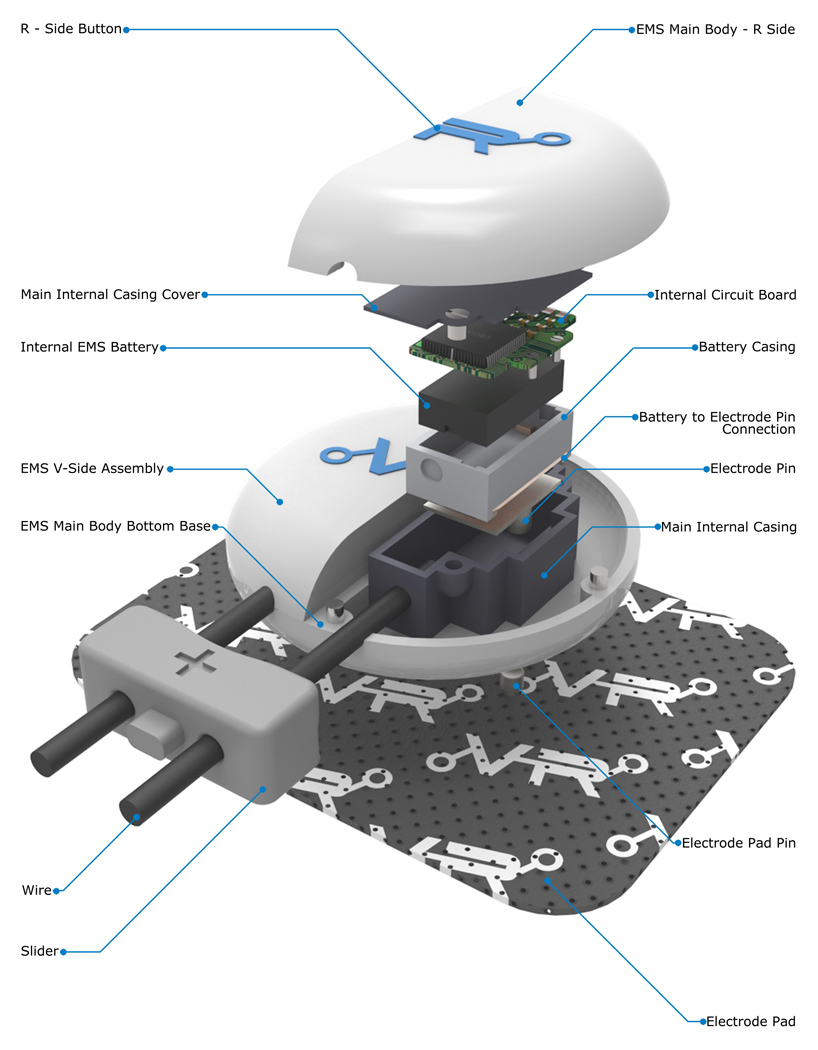
Here is close up exploded view of the VR wireless muscle stimulator, showing individual parts existing in the assembly.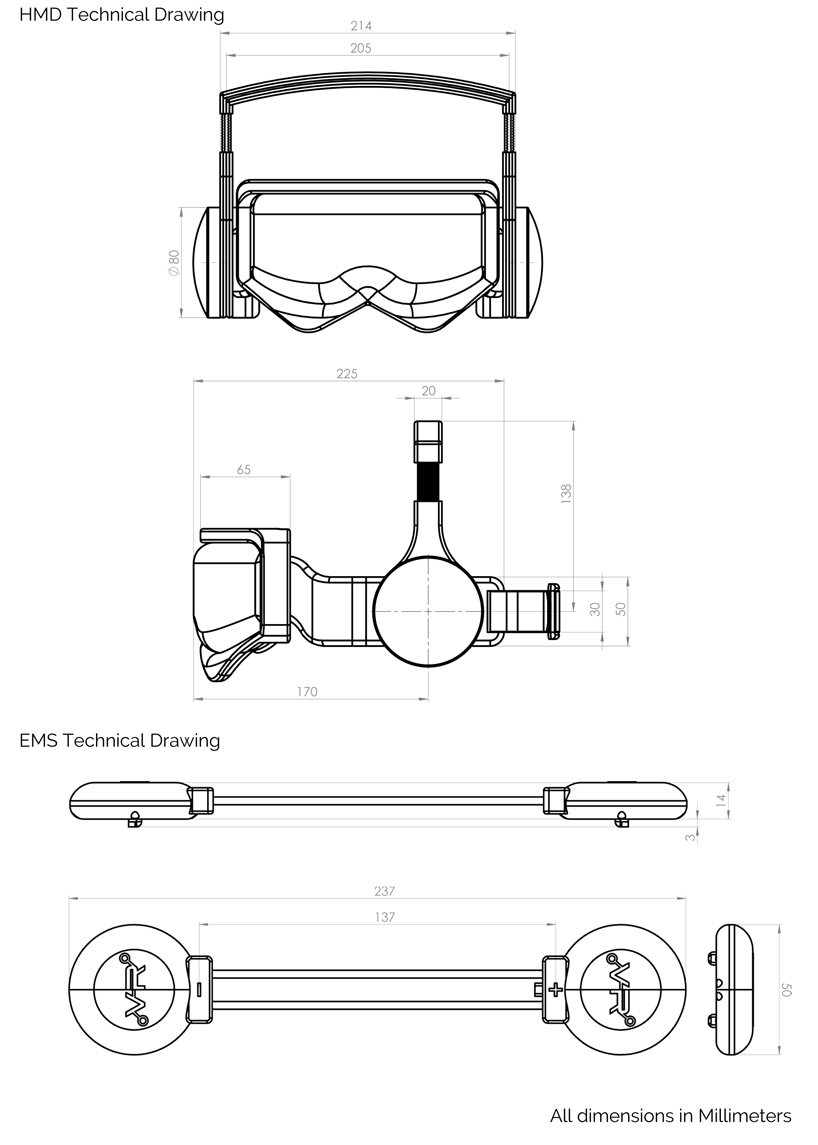
Finally, this picture shows the general arrangements of the Head Mounted Display (HMD) and the Electronic Muscle Stimulator (EMS)